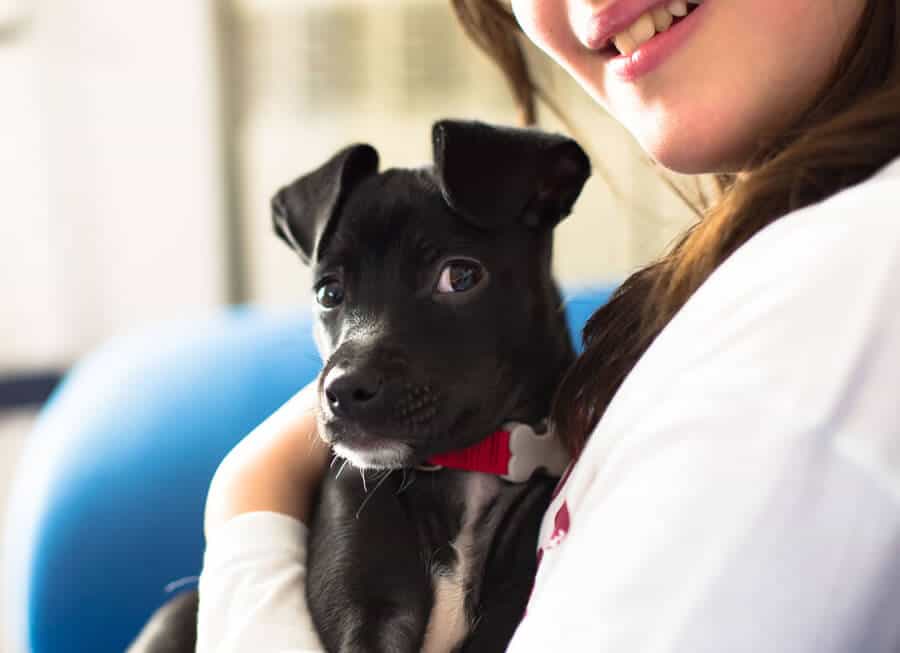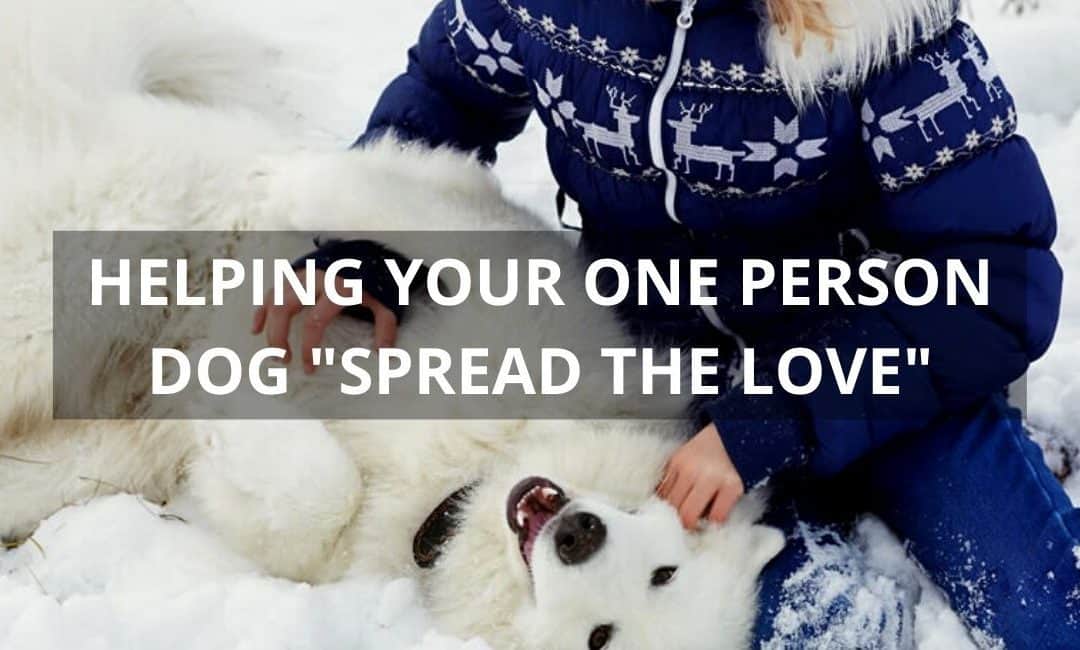Feeling snubbed by your dog? It’s not unusual for a dog to get more attached to one family member than another. Fortunately, whether you have a puppy or adult one-person dog, there are some simple things you can do to help your dog “spread the love”.
Why Do Some Dogs Become One Person Dogs?
Do you have a one person dog at home? A dog that’s way more attached to one family member than anyone else?
It’s not unusual for a dog to listen better to, or even slightly prefer, one family member over another. But when their over-attachment is so black-and-white, it can be tough!
Dogs can get over-attached to one person for several reasons.
There are dog breeds traditionally thought of as “one man dogs” – German Shepherds and Akitas come immediately to mind. It’s very common for dogs of certain breeds to be 100% loyal, devoted, and attached to “their person”. They may be friendly and happy to be around different family members, but they always see that one relationship as elevated far above any other.
Adult rescue dogs from difficult situations may be the most likely to over-bond to one individual in a new home. This might be the first person they developed a bond with. Or it could be the person who was least threatening, most sympathetic, or that gave them the most comfort (or space) when they needed it.
But puppies with no bad history can also develop into one person dogs. It can happen when one family member assumes most or all of the puppy raising duties. That puppy will naturally develop a closer relationship to one person.
I’ve known many cases where a pup got sick or injured and the puppy needed constant care for weeks or months. Those pups always bonded like superglue to their caregivers.
And, of course, dogs can simply enjoy the company of certain people more than another. (We do the exact same thing, right?)
Most instances of “person-preference” in dogs are mild, and more a source of funny anecdotes than any real inconvenience to the family or harm to the dog.
But when a dog bonds very strongly to one member of the family, to the complete exclusion of the others, it can create difficulty both for the dog and people involved.
Why One Person Dogs Can Be a Problem
Truly one person dogs are only happy when they are around their person.
In severe cases, they may mope, hide away, refuse to play or even eat when “their” person is away from home.
They may become stressed or uncooperative if they need to be handled or transported.
They may refuse to mind, or refuse to be consoled, when their person isn’t there.
The situation can become particularly troublesome if the “out of favor” family member begins feeling snubbed and rejected by the dog. And honestly, it’s hard to blame them!
Can One Person Dogs Change?
Fortunately, dogs are nothing if not adaptable, and this includes one person dogs.
Whether you have a puppy or adult dog, born in the home, purchased as a pup, or brought into the family at an older age, there are some simple things you can do to help your dog “spread the love”. Yes, even if you have a dog that’s considered a “one man dog”.
The following suggestions can be used preventatively with dogs who aren’t over-attached, as well as remedially with dogs that have already decided that mom is as sweet as a liver treat, while dad is as dry as an old biscuit (or vice versa!).

How to Help Your One-Person Dog Spread the Love
If you simply want to avoid your dog developing a strong preference for one family member over another, just pick and choose what you like from among the suggestions.
If your dog has already bonded noticeably with one person, you will do no harm by having the “less favored” person(s) introduce one item at a time.
Start with ones that feel most do-able, over time adding in more as the dog’s balance of affection becomes more reasonably distributed.
For ease of writing, I am assuming you, the reader, are the person who needs to begin to exist in your dog’s eyes. Obviously, you can substitute anyone in your family or circle of close friends for “you†in the tips below 🙂
Split the chores
Having the “person of less interest” take over feeding the dog is generally the first recommended change to make.
This works best if your dog really looks forward to mealtimes! Feeding your dog regularly scheduled meals will create more excitement and anticipation than free feeding (with food lying out all the time).
Other ways to make yourself more relevant to the dog are taking her outside for bathroom breaks, brushing her, and walking her.
For now, avoid associating yourself with any duties your dog may find unpleasant, such as baths and nail clipping.
Create awesome associations
Make a list of your dog’s favorite things and activities, and associate yourself with the things she likes best. Does she love chin scritches? Learn how to be the very best chin scritcher! Is she crazy for her Kong toy? From now on, the Kong lives in your pocket. Etc!
Similarly, do you have something you do that dogs love you for? My husband has a talent for sending every dog we’ve owned into paroxysms of ecstasy with rump scratches. Not to mention a near-magical ability to find any dog’s “sleepy spot” (the rubbing of which will send a dog fast to sleep).
Do you have a hidden dog-pleasing talent? Gently test out things you dog might enjoy, and see what happens.
Train the dog
To say right off: because training your dog builds trust, respect, and understanding, everyone in the family old enough to do so should practice the basics of training the dog.
But if you want to truly elevate yourself in your dog’s eyes, become the dog’s primary trainer.
Assuming the training is gentle, patient, reward-based, this is a wonderful way to help your one person dog become more balanced in their relationships. A big added bonus is that you’ll get to know your dog better and learn to see things from their perspective. Nice!
Get involved in something new and different
A terrific way to forge a bond with a dog is to take on some challenge together. This is also a good option if taking over all your dog’s training isn’t practical.
What kinds of challenges build new bonds in one person dogs?
You can teach your dog a series of new tricks that you can show off to friends and family. Take a fun agility class. Practice for and earn a Canine Good Citizen certificate. Teach your dog to track you through the woods.
Pick something you think you’ll enjoy, and just do it!
Wrapping Up
As you can see, there are lots of possibilities for helping your one person dog spread the love around a little.
A dog whose affections are more evenly distributed in the family will still be a loyal, loving companion. But he’ll be one who gets less stressed, and who listens better when that special person can’t be around.
I hope you’ll give these tips a try!
Best,
julie
(bio)
